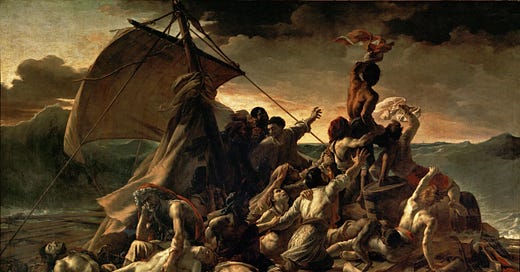Last week I was in Paris. This doesn’t happen often, so my family and I did all the Parisian things: climbing the Eiffel Tower, eating fancy cakes, siting in brasseries. I had the idea that I’d spend a few days being a Flâneur - strolling the streets with a silver-tipped cane, sipping absinthe, writing a bit of poetry with a carnation in my buttonhole, that sort of thing - but like many of my little fantasies, this one never got off the ground. It turns out that it’s not 1920 anymore. Besides, it doesn’t really work with children in tow, I walk too fast, and the process of people-watching is far less interesting now that at least 50% of the people are just staring at their phones as they pass by.
But I did do that most Parisian of things, visiting the Louvre, which is about a hundred art galleries pretending to be just one, all housed in a wildly over-gilted palace which instantly explains why the revolution happened. After a while, the experience is overwhelming. There are millennia of human passions in there, all rendered in oil, watercolour, stone, gold. It is impossible to even think about Flâneuring in a place like that, what with thousands of people all milling about in front of thousands of great works, and a seven-mile queue to take selfies in front of the Mona Lisa. After a while, I found that the whole experience was giving me wild mood swings - from excitement to boredom to anger to intrigue to frustration - and it all seemed to take me into some strange kind of hallucinatory artistic vortex. From there, for an instant, I felt like I could see what so many of these artists, over so many centuries, had been grasping at.
Of course, there might be a lot of things that artists are grasping at, and most probably have no idea themselves. But as I stood in one of the huge galleries of the museum, which after a while seem to meld into one long Tunnel Of Art, it seemed to me that what was being reached for in so many of these works was the oldest of all the old human desires: salvation.
The Coronation of Napoleon: save us!
Napoleon’s Retreat from Moscow: save us!
The Wedding Feast at Cana: save us!
The Crucifixion: save us!
The Death of Marat: save us!
The Raft of the Medusa: save us!
Herakles Fighting the Hydra: save us!
Once I saw this, of course, it was everywhere. On and on it seemed to flow, this great human plea for knowledge, understanding, meaning and, over and through it all, help. Through the journey of human history was woven this desire for release from suffering, this quest for meaning, this longing for an end to the struggle. It was all here, in gallery after gallery. Of course it was. Who among us, if we’re honest, does not want to be saved?
The last two essays in this series have explored the qualitative shift in our way of seeing that technological modernity seems to have brought about. In There Were Giants in the Earth I looked into the possibility that the coming of electricity changed our relationship with the world around us at a deep cultural and spiritual level. In The Fourth Revolution I explored how this altered way of seeing had played into current attempts to ‘save the planet’, as those who set out to do so are drawn, wittingly or unwittingly, into a mechanistic relationship with nature.
In this final installment, I want to ask a final question: as this shift in our way of seeing continues to play out, what will be the impact on our spiritual life? Or, to ask the question more concisely: how will our religious impulse manifest in the age of the Machine?
Keep reading with a 7-day free trial
Subscribe to The Abbey of Misrule to keep reading this post and get 7 days of free access to the full post archives.





